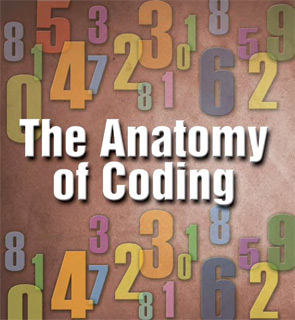
It is essential for coders to understand the rules of engagement, especially when it comes to correct coding and using the most up-to-date coding tools. Those who interact with Current Procedural Terminology (CPT), the International Classification of Diseases (ICD), or insurance companies also have the experience of dealing with the countless coding rules and guidelines.
There is an anatomy for ICD-9-CM, Healthcare Common Procedure Coding System (HCPCS), and CPT that all coders should know.
ICD-9-Clinical Modification (CM)
ICD-9 codes are created by the World Health Organization to report diseases, signs, and symptoms for healthcare data for patients receiving medical care. To ensure coding accuracy for diagnoses, coders should have full comprehension of the three-volume ICD-9-CM manual. Volumes One and Two are made up of the tabular and alphabetical index, which is for both outpatient and inpatient diagnoses, and Volume Three is the classification section for surgical, diagnostic, and therapeutic procedures for the inpatient setting only. Physician coding and billing staff will use only Volumes One and Two.
The first basic coding guideline for using the manual is to never code from only one section of the book. Other important tips include:
- Understand the proper usage and sequencing of the alphabetical and tabular index (both sections of the index should be used for final coding);
- Know how to locate terms in the alphabetical index;
- Code to the highest level of specificity using fourth and fifth digits;
- Ensure the correct selection of primary diagnosis codes as well as V codes;
- Understand the use of signs and symptoms;
- Understand the code selection of acute versus chronic conditions; and
- Know when to use multiple codes for a single condition.
To ensure accurate coding for a diagnosis, it should always be coded to the highest specificity. Diagnosis codes are listed in three, four, and five digits. The fourth and fifth digit gives the code more specification. For example:
- 724 Other and unspecified disorders of back
- 724.0 Spinal stenosis, other than cervical
- 724.02 Lumbar region, without neurogenic claudication
There are other coding conventions in the ICD-9 manual, such as abbreviations, symbols, and punctuation, that are not included in the general guidelines. These coding conventions are added in the alphabetical and tabular index with instructional notes. Coders should become familiar with these conventions, which include:
- Abbreviations NEC (not elsewhere classified) and NOS (not otherwise specified). These code assignments are used when the diagnostic statement in the medical record provides sufficient information to assign a more specific code.
- Punctuation usage, such as [ ], [ ], and ( ).
- Include and exclude notes.
- The meaning of “and,” “see also,” and “with.”
- The meaning of “use additional code” and “code first.”
Additionally, if routine tests are ordered during a patient visit to evaluate any sign or symptom, it is appropriate to assign the primary code as well as the V code. Coders should always apply the necessary guidelines for each patient record to substantiate what is billed.
CPT
CPT codes are developed and maintained by the American Medical Association (AMA) and assigned to every procedure or service provided in a physician practice. A CPT code is alphanumeric with five digits. The manual also has both an alphabetical and tabular section. There are three types of CPT codes:
- Category I: procedures that are widely performed and consistent with medical practices;
- Category II: supplementary tracking codes that can be used for performance measures; and
- Category III: temporary codes for emerging technology, services, and procedures.
The manual includes coding guidelines at the front of the book and should be reviewed by all coders to assign the correct codes. Coders can also find distinctive instructions at the beginning of a code set to assist with better code assignment. Learning and understating these instructions will aid the physician in sustaining the medical necessity of the code billed for the service performed during a patient visit. Category I codes are mainly used in the outpatient setting and are divided into six sections:
- Evaluation and Management: 99201–99479
- Anesthesia: 00100–01999
- Surgery: 10021–69990
- Radiology: 70010–79999
- Pathology and Laboratory: 80047–89398
- Medicine: 90281–99607
The ACR has developed a Rheumatology Coding Manual, which is available to members at www.rheumatology.org/publications, under Practice Management Publications. The manual is a practical guide for rheumatologists and their staff to effectively report the codes that are most applicable to rheumatology. Keep in mind that the specialty manual should not be substituted for the entire AMA CPT manual, but should be used concurrently.
